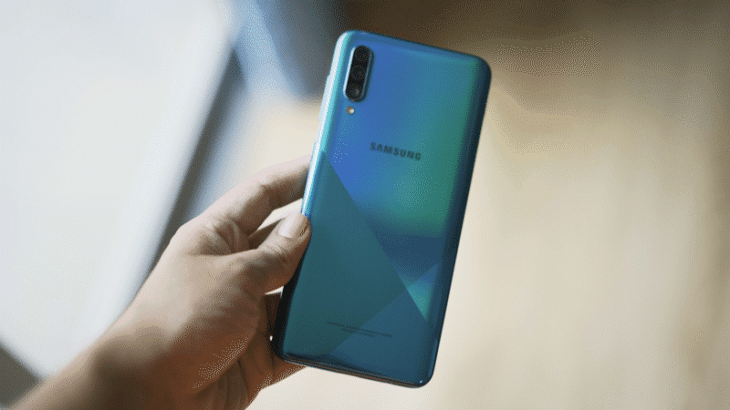Samsung Galaxy A30s Review: Attractive Design But Weak Configuration
Anita - Oct 07, 2019

The Galaxy A30s has a beautiful luxury rear panel, an Infinity-U display, vivid display, an on-screen fingerprint sensor, and easy-to-use OneUI interface.
- OPPO Reno 14 Series Hits India: Launch Date, Cameras, and Specs
- Best Gaming Phones 2025: Top Devices for Mobile Gaming
- Samsung Odyssey 2025 Gaming Monitors Launch in India with Revolutionary Features
In recent times, Samsung has been focusing on the mid-range segment like what it announced previously. Only about 6-7 months ago, the brand launched the first Galaxy A series smartphones, the Galaxy A30 and A50. Recently, their successors, the Galaxy A30s and A50s have been also released.
For those who are interested in the Galaxy A30s, we will spend time on this phone to see whether we should buy it not.
Just like the A50s, the A30s impresses users when wearing a new diamond-cut design with a single-colored back. The rear panel is partly matte and glossy. And the glossy part also comes with gradient effect under the sunlight or strong light sources. The type of plastic used by the company offers a quite firm grip feel.

At the back, there is only a triple camera setup and no fingerprint reader like the A30. The camera module has been upgraded in both quality and quantity, including a 25MP main sensor (up from 16MP), an 8MP ultra-wide-angle sensor (up to 3MP) and an additional depth sensor.

Recently Samsung has adjusted the image algorithm, so the photos from Galaxy A30s are no longer too bright or too dark, so it feels more pleasing to the eye. Sometimes the image will still be bluish, but users can still use an app to adjust it easily.

The wide-angle sensor of the phone is an old-gen sensor, so the sharpness, as well as the ability to handle DR, is still inferior to those used on high-end models such as Galaxy S10, and Galaxy Note 10. The Galaxy A30s also has no telephoto sensor, so every time you have to shoot from a long distance, you will have to zoom from the main sensor, which reduces image quality.

The ports have no changes compared to the A30, including a USB Type-C port that supports 15W charging and a 3.5mm port.

On the front, we see a 6.4-inch AMOLED screen with many highlights. For instance, the display offers real black because it is possible to turn off some of the pixels. In addition, the color of the display is also more vivid than that of the LCD panel. The panel used for the A30s is also much better in color than other rivals in the same segment.

The screen has an Infinity-U cut-out for housing a 16MP f/2.0 selfie camera, which makes it have a really thin top bezel. In contrast, the device has a thin at the bottom edge. Generally, the display still has a large screen-to-body ratio, and the bottom edge also helps swipe navigation gestures on OneUI become more comfortable.

The reason why the A30s does not have a fingerprint sensor on the back like the A30 is that it is put under the screen. This is the same sensor used for the Galaxy Tab S6 and Galaxy A50s, giving a much faster and more accurate reading speed than the older generation found in the A50.

Is this display awesome? If all the advantages mentioned above have impressed you, then the next parameter will bring you down. The panel used on the Galaxy A30s only has HD+ (720 x 1560 pixel) resolution. This is a confusing decision of Samsung when its predecessor has a FullHD+ (1080 x 2340 pixel) AMOLED screen!

For those who have never used a high-resolution screen, they will surely get used to the Galaxy A30s after a period of use. But those who have been used to a smartphone with FullHD resolution or higher, they will immediately see this display is disappointing. If they came closer, they can even see each pixel. Not to mention, as the AMOLED panel offers resolution which always looks lower than the LCD due to the arrangement of the pixels, the 720p resolution on AMOLED even looks more 'porous' than 720p LCD.
The configuration is also no longer a highlight of the Galaxy A30s. It is powered by a 14nm Exynos 7904 chipset manufactured by Samsung, coupled with 3GB/4GB of RAM and 32GB/64GB of internal storage, which is entirely similar to the Galaxy A30.

The performance score of Exynos 7904 is lower than that of Qualcomm Snapdragon 660, an old mid-range chipset used by many devices of other brands. This means that the Galaxy A30s sometimes lags behind in regular operations, and are really weak when doing heavy tasks like games.
For those who only use the phone for calling/answering phone calls or surfing online, the A30s will probably be able to meet their demand, but those who have used the higher-end models will clearly notice the differences. In the gaming session, the Galaxy A30s will have higher performance than A30 because its screen resolution is lower.
Another plus point on the Galaxy A30s is its good battery capacity due to the decline in the screen resolution and acceptable configuration. With a 4,000mAh battery, the phone always lasts for a day, even to the second day if users do not use it much.
Final thoughts
As a new generation A-series smartphone from Samsung, the Galaxy A30s has a few interesting points including the beautiful luxury rear panel, the Infinity-U display, AMOLED panel for real black, vivid display, an on-screen fingerprint sensor for a modern feel, and easy-to-use OneUI interface.

But the two more important points for users are the decline in the screen quality and the configuration, which affects the actual experience. As stated in the article many times, these minus points will not become a problem for those who do not require much from the phone or have not used high-end smartphones before. However, if you have a more comfortable budget, you should consider another phone like the A50s.
Currently, the Galaxy A30s has the price of Rs. 16,999 for the 4GB RAM and 64GB internal storage variant. The handset is available in the Indian market from September 11, across Samsung Opera House, Samsung e-shop, e-commerce sites, and offline stores.
Featured Stories

Review - Aug 23, 2025
Revolutionize Your Communication: How to Buy Virtual Numbers on Telegram

Review - Jun 25, 2025
Windows 11 Problems: Is Microsoft's "Best" OS Actually Getting Worse?

Features - Jun 18, 2025
Best Mobile VPN Apps for Gaming 2025: Complete Guide

Review - Jun 18, 2025
Nintendo Switch 2 Review: A Triumphant Evolution Worth the Wait

Mobile - Jun 12, 2025
Best Gaming Phones 2025: Top Devices for Mobile Gaming

Mobile - Jun 12, 2025
Vivo T4 Ultra Debuts with MediaTek Dimensity 9300+ Chipset

Gadgets - Jun 12, 2025
Lava Prowatch Xtreme Launches with Google Fit Integration

Mobile - Jun 08, 2025
Realme GT 7T Review: Power Meets Endurance in Controversial Style

Mobile - Jun 07, 2025
Realme C73 5G Launches in India: Budget 5G Phone Starts at ₹10,499

Review - Jun 07, 2025
Comments
Sort by Newest | Popular